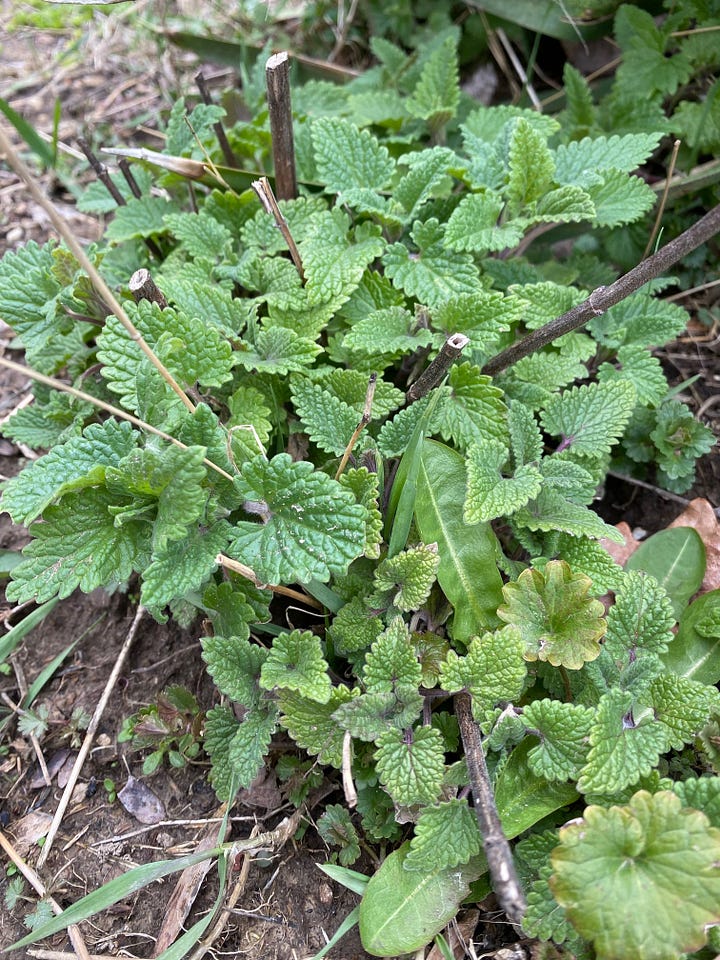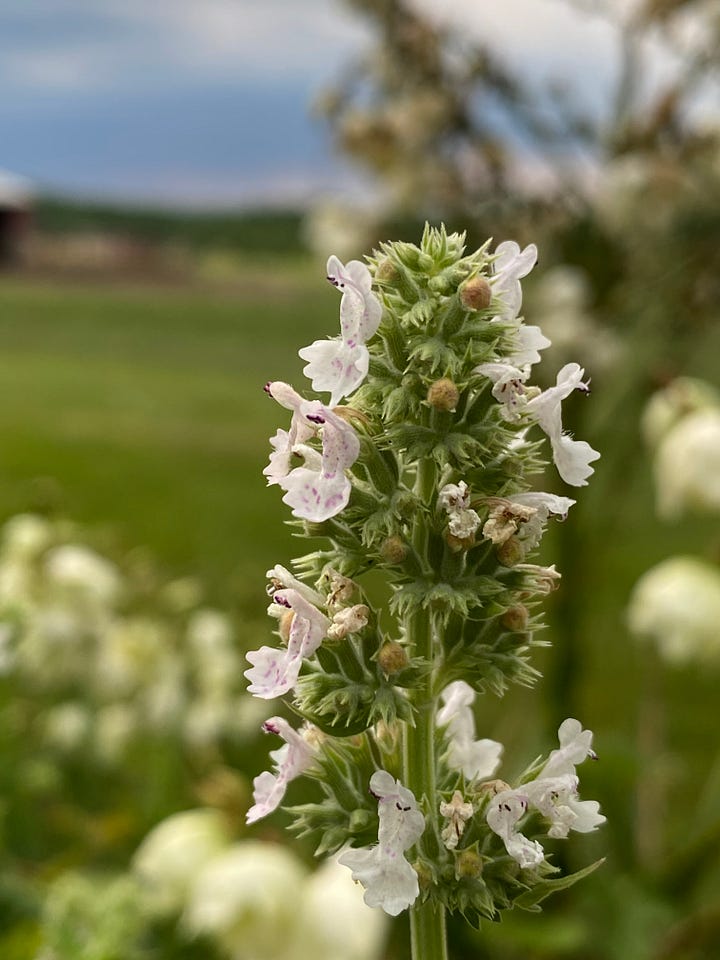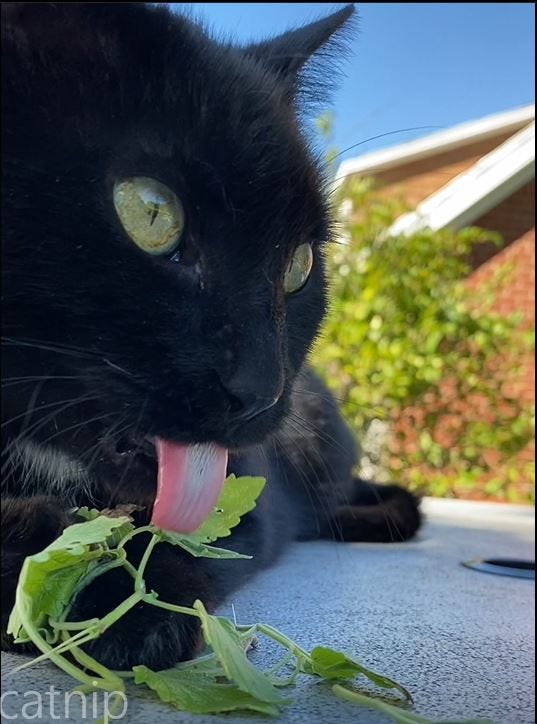Catnip 1
A Healthy Buzz
Humans have been long been entertained by the behavior of cats when they’re buzzing on Catnip. For the show, we enable them in their use of the weed. (Cats’ habits surely preceded our assistance.) Studies indicate that various feline species have obtained protection from mosquitos by rolling and indulging in the catnip, Nepeta cataria, which produces the iridoid compound, nepetalactone. Another kitty attracting species, Silvervine (Actinidia polygama), produces a cocktail of related iridoid compounds that repels a wider variety of insects. Our kitties are obtaining more than just a buzz from the use of their own wild weed.
While catnip causes a pheromone like stimulation in cats, it is mildly sedating in humans and calming to the gut. There is a long tradition of catnip use for colic in babies. Herbalists recognize it as antispasmodic, carminative, nervine, emmenagogue, astringent, diuretic, and diaphoretic in effect. Many mention that this latter effect of inducing sweating is accomplished without warming influence. Though relatively non-toxic, very large doses of the tea can act as an emetic. Catnip has been used topically to lessen swelling, and to relieve hemorrhoidal discomfort. Pregnant women, and those wanting to be pregnant should not use catnip internally.
Hardy in zones 3a thru 9b, catnip is a perennial weed in the Weedom Zone (6). In sheltered places small catnip plants stayed green throughout the winter. Otherwise the bushes have died back, then sent up green shoots from the base at winter’s end.


Let’s do the botany, and solidify the distinction between the real Nepeta cataria, and some other locally available members of the genus. From the family, Laminaceae, this plant is exhibits variability in its output of phytochemicals, depending on culture, and manner of extracting the constituents. Catnip hails originally from Europe, the Middle East, and temperate parts of Asia and Africa, but is heavily naturalized in North America. We spotted a possible cross between catnip and peppermint in our own landscape, which gave forth an in-between odor, and we’re hoping it rises again from the rhizomes this year for further study, as we weren’t able to get a viable cutting.
Catnip leaves are super soft, downy, grayish green, triangular shaped, and are supported by fuzzy petioles emerging oppositely from square, grayish green to brown, stems. Leaf veins are oppositely arranged from a central vein. The stems, which are downy when young, become more woody as they age. Leaves are 1 to 3 inches wide, up to 3 or more inches long, with coarse (crenate) teeth. Plants can become bushy and reach 3 to 4 feet in height. Tubular lowers vary from purple or lavender, speckled to white in color, tubular with two lips, and appear from mid spring to the fall. They are arranged in whorls atop the stems, in racemes that are 1 to 6 inches long. Butterflies, moths and bees swarm the flowers heavily. Copious seeds are formed so with the perennial nature, tolerance to various growing conditions, and large potential for new growth, you might wish to confine catnip a little bit. Some people use the term catmint and catnip interchangeably. Others distinguish Nepeta mussini, (Persian catmint) a more tame, rounded perennial bush, worthy of the landscape. It produces lavender blooms like mad, but provides little to no stimulation for cats. Catnip is wilder, weedier, taller, often with larger floral racemes. Other related “flavors” of the weed are Nepeta parnassica, Greek catmint, with pink blooms, Nepeta camphorata, camphor catmint, having white blooms specked with purple, and taller Nepeta citriodora, lemon catmint with white and purple blooms.



At Weedom, we have discovered that cat happiness often exceeds culinary and medicinal herbs on people’s hierarchy of needs. We dry our excess of catnip weeds, and sell them. It’s potent stuff, and we’ve been raided at the farmer’s market by a feral cat that receives copious social benefits in the neighborhood. This kitty, who once hopped onto our dried herb display and drooled, is a stoner. We enabled her habit on several occasions at last summer’s market.
Some herbal references, such as David Hoffman’s Medical Herbalism, appear to describe Nepeta citriodora’s array of constituents under the name Nepeta cataria. The latter herb produces an essential oil which is about 60-75% comprised of nepetalactones. Nepeta citriodora is the one with the lemony scent, the nerol, neral, citronellol, citronellal, geraniol and geranial. Overall, researchers seem to agree that the unfractionated (whole) essential oil of catnip is superior to the purified nepetalactone as an insect repellant, as well as happiness to cats. It compares favorably to DEET with one tenth of the toxicity. It’s also a great deal safer than pulegone, the insecticidal component of pennyroyal, though, as previously mentioned, pregnant women need to avoid both, most particularly the internal use.
In the 1960s, people would smoke anything, so naturally they tried Catnip. Kitties had strong competition for their cat toys and other catnip products. Their humans used it as a cannabis extender, or with tobacco. Ongoing reports appear in Erowid from those who have tried catnip by various routes of administration. A mild, transient sedation or buzz, seems to be the most common experience. (For the uninitiated, Erowid is a site where people report the effects of using various psychotropic substances, mainly those which are homegrown or available from “street pharmacists”.)
Much of the nervine quality of Catnip is expected to be found in the volatile constituents, in other words, what gets lost when you heat it up. So don’t boil this herb. If you make an infusion, place the herb in a hot water in a covered tea pot to retain more of the oils. Much of the traditional medicinal quality of catnip was obtained from the flowering tops, however the remedy for stimulating menstruation was the green herbal portion, juiced and taken directly in tablespoon quantities. The leaves also appear to be the more insect repellant portion of the plant. The root of catnip was reputed to be an irritant, which “would make the most gentle person quarrelsome” says Mrs. M. Grieve in ‘A Modern Herbal’.
At Weedom, we find both the leaves and the flowering tops useful. Drying should be done in a dark place, and then the herb should be sealed in jars and kept in a cool dark place. Catnip stored in bags or out in the light will lose potency more quickly, particularly that nepetalactone constituent which is most attractive to cats.
Since Catnip is found in Europe, India and the Middle East, our pharmacognosy friends have elucidated phytochemistry which supports the oldest known uses of this plant, as well as some newer applications. We will follow up with part two (Catnip-2) which will delve further into nervine, anti-inflammatory, anti-microbial, anti-cancer and hepatoprotective potentials of this weed, and a bit more on the insect repellent uses. We’re also returning to video boot-camp for a little bit of fun. Hit that comment button, and tell us what you think. And stay tuned!!
Where We Dig
1. Murai F, Tagawa M, Damtoft S, Jensen SR, Nielsen BJ. (1R, 5R, 8S, 9S)-Deoxyloganic Acid from Nepeta cataria. Chemical & Pharmaceutical Bulletin. 1984;32(7):2809-2814. doi:10.1248/cpb.32.2809
2. Can You Smoke Catnip? Effects And Benefits | Smokable Herbs. Published April 30, 2020. Accessed March 23, 2023. https://www.smokableherbs.com/catnip/
3. Catnip (also Nepeta cataria) : Erowid Exp: Main Index. Accessed March 29, 2023. https://www.erowid.org/experiences/subs/exp_Catnip.shtml#Retrospective_/_Summary
4. Grognet J. Catnip: Its uses and effects, past and present. Can Vet J. 1990;31(6):455-456.
5. Joshi M, . H, Kumar R, Prakash O, Pant A, Rawat D. Chemical composition and biological activities of Nepeta hindostana (Roth) Haines, Nepeta graciliflora Benth. and Nepeta cataria L. from India. 2021;12:35-46.
6. Different Catnip Plants – Information On Common Varieties Of Catnip. Gardening Know How. Published March 4, 2021. Accessed March 28, 2023. https://www.gardeningknowhow.com/edible/herbs/catnip/catnip-plant-varieties.htm
7. Uenoyama R, Miyazaki T, Adachi M, Nishikawa T, Hurst JL, Miyazaki M. Domestic cat damage to plant leaves containing iridoids enhances chemical repellency to pests. iScience. 2022;25(7):104455. doi:10.1016/j.isci.2022.104455
8. Zhu JJ, Zeng XP, Berkebile D, Du HJ, Tong Y, Qian K. Efficacy and safety of catnip (Nepeta cataria) as a novel filth fly repellent. Med Vet Entomol. 2009;23(3):209-216. doi:10.1111/j.1365-2915.2009.00809.x
9. Everything You Need to Know About Nepeta Cataria. Accessed March 22, 2023. https://nepetacataria.org/
10. Chauhan KR, Klun JA, Debboun M, Kramer M. Feeding deterrent effects of catnip oil components compared with two synthetic amides against Aedes aegypti. J Med Entomol. 2005;42(4):643-646. doi:10.1603/0022-2585(2005)042[0643:fdeoco]2.0.co;2
11. Ganora L. Herbal Constituents, 2nd Edition - Foundations of Phytochemistry. Lulu Press, Inc.; 2021. https://openlibrary.org/books/OL35083771M/Herbal_Constituents_2nd_Edition
12. Hutchens AR. Indian Herbalogy of North America. Shambhala; Distributed in the United States by Random House; 1991. https://openlibrary.org/books/OL1567124M/Indian_herbalogy_of_North_America
13. Patel H, Gomes EN, Yuan B, Lyu W, Wu Q, Simon JE. Investigation of Volatile Iridoid Terpenes in Nepeta cataria L. (Catnip) Genotypes. Molecules. 2022;27(20):7057. doi:10.3390/molecules27207057
14. Hoffmann D. Medical Herbalism: The Science and Practice of Herbal Medicine. Healing Arts Press; 2003.
15. Nepeta cataria - Southern Cross University. Accessed March 22, 2023. https://www.scu.edu.au/analytical-research-laboratory---arl/medicinal-plant-garden/medicinal-plant-monographs/nepeta-cataria/
16. Acimovic M, Zeremski T, Kiprovski B, et al. Nepeta cataria -Cultivation, Chemical Composition and Biological Activity. 2021;4:620-634.
17. Nepeta cataria (Catmint, Catnip, Catswort) | North Carolina Extension Gardener Plant Toolbox. Accessed March 22, 2023. https://plants.ces.ncsu.edu/plants/nepeta-cataria/
18. Hogenbom J, Istanbouli M, Faraone N. Novel β-Cyclodextrin and Catnip Essential Oil Inclusion Complex and Its Tick Repellent Properties. Molecules. 2021;26(23):7391. doi:10.3390/molecules26237391
19. Birkett MA, Hassanali A, Hoglund S, Pettersson J, Pickett JA. Repellent activity of catmint, Nepeta cataria, and iridoid nepetalactone isomers against Afro-tropical mosquitoes, ixodid ticks and red poultry mites. Phytochemistry. 2011;72(1):109-114. doi:10.1016/j.phytochem.2010.09.016
20. DerMarderosian A, Buetler J. Review of Natural Products. 8th edition. Lippincott Williams & Wilkins; Facts and Comparisons; 2014. https://openlibrary.org/books/OL27960482M/Review_of_Natural_Products
21. Patience GS, Karirekinyana G, Galli F, et al. Sustainable manufacture of insect repellents derived from Nepeta cataria. Sci Rep. 2018;8(1):2235. doi:10.1038/s41598-017-18141-z
22. Melo N, Capek M, Arenas OM, et al. The irritant receptor TRPA1 mediates the mosquito repellent effect of catnip. Curr Biol. 2021;31(9):1988-1994.e5. doi:10.1016/j.cub.2021.02.010
23. Easley T. The Modern Herbal Dispensatory - a Medicine-Making Guide.; 2016. https://openlibrary.org/books/OL26933940M/The_modern_herbal_dispensatory
24. Patel HK, Gomes EN, Wu Q, et al. Volatile metabolites from new cultivars of catnip and oregano as potential antibacterial and insect repellent agents. Front Plant Sci. 2023;14:1124305. doi:10.3389/fpls.2023.1124305







